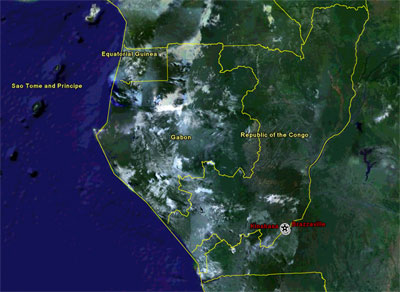EQUATORIAL GUINEA
Please note, this page is not longer being updated. For more recent information, please see news.mongabay.com and use the search function to find the country feed. For more up-to-date data on forest cover and loss, check out Global Forest Watch.
| Equatorial Guinea Forest Figures
Forest Cover Total forest area: 1,632,000 ha % of land area: 58.2% Primary forest cover: n/a % of land area: n/a % total forest area: n/a Deforestation Rates, 2000-2005 Annual change in forest cover: -15,200 ha Annual deforestation rate: -0.9% Change in defor. rate since '90s: 8.9% Total forest loss since 1990: -228,000 ha Total forest loss since 1990:-12.3% Primary or "Old-growth" forests Annual loss of primary forests: n/a Annual deforestation rate: n/a Change in deforestation rate since '90s: n/a Primary forest loss since 1990: n/a Primary forest loss since 1990:n/a Forest Classification Public: n/a Private: n/a Other: n/a Use Production: n/a Protection: n/a Conservation: n/a Social services: n/a Multiple purpose: n/a None or unknown: n/a Forest Area Breakdown Total area: 1,632,000 ha Primary: n/a Modified natural: n/a Semi-natural: n/a Production plantation: n/a Production plantation: n/a Plantations Plantations, 2005: n/a % of total forest cover: n/a Annual change rate (00-05): n/a Carbon storage Above-ground biomass: 186 M t Below-ground biomass: 45 M t Area annually affected by Fire: n/a Insects: n/a Diseases: n/a Number of tree species in IUCN red list Number of native tree species: n/a Critically endangered: 1 Endangered: 4 Vulnerable: 11 Wood removal 2005 Industrial roundwood: 419,000 m3 o.b. Wood fuel: 514,000 m3 o.b. Value of forest products, 2005 Industrial roundwood: n/a Wood fuel: n/a Non-wood forest products (NWFPs): n/a Total Value: n/a More forest statistics for Equatorial Guinea |
This biodiverse country has been heavily impacted over the last 35 years by agriculture and timber harvesting. Primary rainforest covered 50 percent of the country and secondary forest 10 percent in 1959. By 1985, primary coverage had been reduced to 28 percent, while secondary coverage had fallen to 8 percent. The most diverse region, the coastal Mbini, has been hit the hardest by deforestation. Most of the remaining primary forests are located in inaccessible parts of the interior.
Additional threats to the forest come from natural gas fields and oil exploration. Extensive hunting for food and trapping for the exotic pet trade are taking their toll on this country's wildlife.
On paper, 16.8 percent of the country is under some form of protection.
Suggested reading - Books
Unless otherwise specified, this article was written by Rhett A. Butler [Bibliographic citation for this page]
Other resources
Contact me if you have suggestions on other rainforest-related environmental sites and resources for this country.

Image copyright Google Earth, MDA EarthSet, DigitalGlobe 2005
CIA-World Factbook Profile
FAO-Forestry Profile
World Resources Institute (PDF)
Last updated: 4 Feb 2006
